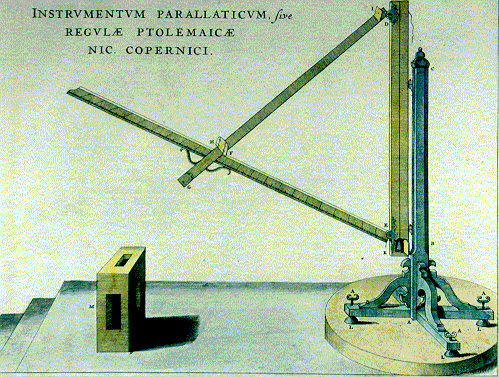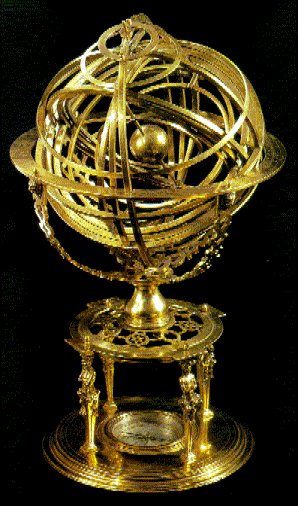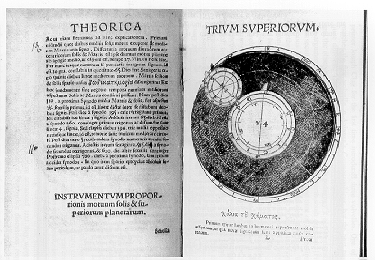
"Ptolemy's rulers." From Tycho Brahe, Astronomiae Instauratae Mechanica (1598) |
Astronomy was a mathematical science dependent on measurement. For the most part, its practitioners spent their time recording and attempting to account for planetary appearances. They were concerned not with the nature of the planets themselves, but with where in the sky they might be seen at a given moment. They constructed theoretical mechanisms to track these appearances, and, they hoped, to predict them for the future. On their success in this enterprise depended such socially useful ends as astrology, the establishment of the calendar and the timing of religious festivals, and the administration of medicines. Another use, and one that came to prominence in the Renaissance with the advent of transoceanic voyages, was for navigation.
The practical measurements made by an astronomer were set forth authoritatively by Ptolemy in the Almagest. Ptolemy described in particular several kinds of instrument, each of which was to be used for a distinct observation.
The Instruments
|

"Ptolemy's rulers." From Tycho Brahe, Astronomiae Instauratae Mechanica (1598) |
Among the simplest of these, and perhaps the most influential, was the device known as "Ptolemy's rulers." It was originally stipulated for measuring the angle between the Moon and a point directly overhead, i.e. the Moon's zenith distance.
A plumbline was used to set up a vertical column with a linear scale. One rigid arm was attached by a pivot to the bottom of the column, another similarly to the top. Two sights (e.g., fine slits) are fixed to the ends of the latter. The length of the upper arm equal to the distance along the column between the two pivots is marked off. The upper arm is then aligned to the Moon, and the lower set to cross it at the marked point. The distance along the lower arm can then be read from a scale and readily converted into the zenith angle.

The armillary sphere. This example was made in the 1560s, but follows the classical Ptolemaic pattern. From Turner, Early Scientific Instruments (1987). |
This comprised a set of seven concentric rings rotating around different axes, with the poles of each one anchored in its enclosing ring. The outermost ring was set parallel to the meridian (i.e. in a geographical north-south plane). The next could then be set to the celestial pole - that is, the pole around which the stars seem to move daily as viewed from the Earth. It would then correspond to the latitude of the place where the instrument was being used. A further ring was fixed to this such that its pole reproduced the obliquity of the ecliptic. Four inner rings could then be used to track the distances between particular planets and stars along and perpendicular to the ecliptic. Such angular separations could be read directly from the instrument.
Ptolemy also knew how to use an astrolabe, although he did not describe one in the Almagest. This immensely useful instrument was made and employed for centuries. It was essentially a plane projection of the heavens, adjustable for different latitudes. Once its "rete" (the skeletal disc pointing to stellar positions) had been set for one star's height, the time and other results could be read from the instrument.
Such instruments both served and preserved distinct practical techniques. They confirm that Ptolemaic astronomy was concerned primarily with planetary positions.

Paper instrument representing the epicycle mechanism of a planet's path. From Rheinhold's edition of Peurbach's Theoricae Novae Planetarum (1542): see O. Gingerich, "Astronomical Paper Instruments with moving parts," in R. Anderson, J. Bennett, W. Ryan (eds.), Making Instruments Count (1993). |
One innovation in the use of instruments to which printing gave rise was the paper instrument. Several mathematical and astronomical works of the sixteenth and seventeenth centuries contain manipulable devices made from circles and other shapes cut out of paper. Regiomontanus pioneered these devices, and they appeared in medical works (supplying cutaways of the human frame) and mathematical texts as well as in astronomical books. Some were exclusively for pedagogic purposes, but by the mid-sixteenth century a few paper instruments were being issued that could actually be used to make measurements. By the 1590s some works had complex paper mechanisms up to seven layers deep.
Paper instrument performing the function of an astrolabe. Italy, 1595. From Turner, Early Scientific Instruments (1987). |
Most of these paper instruments can no longer be reconstructed. Surviving copies are frequently incomplete, and in any case dismantling old books in order to make paper instruments is not an interpretative practice viewed kindly in modern libraries. In future issues of Unilab it is hoped that images of the necessary sheets will be made available for combination in the system, reproducing the intended combinations. Users will also be able to produce their own working replicas. Indeed, it is not too fanciful to see a parallel in these paper instruments with the aims of Microcosmos itself. The last years of Ptolemaic astronomy saw its most eminent practitioners seeking to provide through print the kind of dynamic communication that is only now becoming possible with new media. The interactive model of Ptolemaic theorizing that you can experience in Microcosmos is the modern equivalent of their paper instruments. A generation after the invention of printing, Regiomontanus and his followers made the most of new communications technologies to render a clearer understanding of the Ptolemaic enterprise. A generation after the invention of the computer, an analogous development is at hand as we seek to move beyond the static representations of today's textbooks. For a powerpoint presentation about paper instruments, click here. |
Site Map | Contact Us